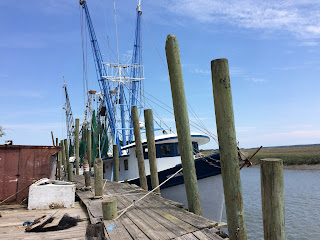Growing up in California, I learned that the first settlement in the United States was in Jamestown in 1607. In fact, there was a settlement in 1565 in St. Augustine, Florida (and the Spanish settled in New Mexico in 1598). The old saying that history is written by the victors is so true. St. Augustine today is touristy but not overly so. The old buildings and original fort, Castillo de San Marcus, are close together and quite lovely. The fort was used to defend the city during a time when the Spanish and British vied for control of the New World. The British controlled the fort following the French and Indian War in 1763 and used it during the Revolutionary War. Then it was in Spanish hands but in 1821 the US acquired Florida from Spain and the fort was used to house American Indians during the Indian Wars.
 |
| Castillo de San Marco |
 |
| The Population of Florida is now nearly 20 million! |
The history of major east coast Florida development revolves around Henry Flagler. While we have all heard of Rockefeller and Standard Oil, Henry Flagler was a cofounder of the company and is credited with taking the company public, this enabling its growth and prominence. Henry's first wife was not well and he took her to Jacksonville, Florida for her health. The change did not provide much benefit and she subsequently died. When Flagler remarried he traveled south to St. Augustine and, not able to slow down and finding accommodations without the amenities to which he was accustomed, he proceeded to build the Ponce de Leon Hotel in 1888.
 |
| Ponce de Leon Hotel-Now Flagler College |
He also bought the Jacksonville, St. Augustine and Halifax Railroad which later became the Florida East Coast Railway System. Over the years, Flagler continued to build the rail line south along the east coast of Florida, adding hotels as he went.
Flagler decided to take the rail line all the way down to Key West. Pigeon Key housed the workmen who built the railroad that connected the Homestead area of South Florida to Key West, starting in 1903. At one time, due to the wrecking business, Key West was the wealthiest city in the US. Shallow waters and the lack of navigation aids resulted in many wrecked ships and the salvage business proved so lucrative that rumors persist that ships were lured to their demise. Before the railroad, the only access to Key West was via boat, over 100 miles. Under Flagler's direction, while he was in his late 70's and 80's, the railroad reached Key West in 1912. The project has been characterized as the most ambitious engineering feat ever undertaken by a private citizen.
 |
| Original Building on Pigeon Key where Railroad Construction Workers were Headquartered |
The railroad ran until 1935, when a hurricane devastated the Keys. The railroad, which was by then suffering financial problems, was seriously damaged and the State of Florida used the still viable columns and paved over the rail bed, permitting the first automobile traffic traversing the Keys.
While staying in St. Augustine, we were again lucky to find a park with a lovely wetlands view.
 |
| Joan enjoying the sunset and Max looking for critters |
Leaving Florida we traveled a mere 100 miles to a lovely resort in Hilton Head, SC. After waiting one night, we scored a very private waterfront campsite.
 |
| Our motorhome looks out at the water and the site has grass and foliage |
We have as neighbors a fun group of 4 brothers, Dad and their male dog enjoying a four day "Boys' Outing." The dog named Jello (the grandkids named him, poor boy) and Max became buddies.
 |
| Max and Jello |
A day's outing to the sea islands, Beaufort and St. Helena, resulted in stocking the freezer with local shrimp and buying a sweetgrass basket from the artisan's front yard. In the Gay Fish Co. shop we met the current Mr. Gay who explained the photos on the wall, ranging from his very young looking Great Grandfather in his Civil War Uniform to his Grandpa and father, who founded the fish company. Mr. Gay grew up on St. Helena and said in his early years thought the only while women in the world were his mother and sister as St. Helena was populated by Black descendants of early slaves on the island.
 |
The Gay Fish Company is named for the owner's father, Mr. Gay and is not a statement of lifestyle preference
|
 |
| Current Owner, Mr. Gay |
 |
| Gay Company Shrimper |
Sweetgrass Baskets are a local specialty and are made from marsh sweetgrass (now hard to find) and wrapped with palmetto strands. They are labor intensive and we found Ms. Lillie on St. Helena Island in her yard weaving baskets and displaying them for sale.
 |
| Lillie Charlton Making Sweetgrass Baskets |
 |
| Sweetgrass Basket |
While Ms. Lillie is from Mt. Pleasant, north of Charleston, her husband is from St. Helena. St. Helena was an isolated Black island community following the Civil War and is known for the African based dialect, Gullah, that was spoken on the island for over 100 years. She said she speaks a bit of Gullah but her husband really does. Sweetgrass baskets are an African tradition and were originally used to collect rice in the "Rice Coast of West Africa."















No comments:
Post a Comment